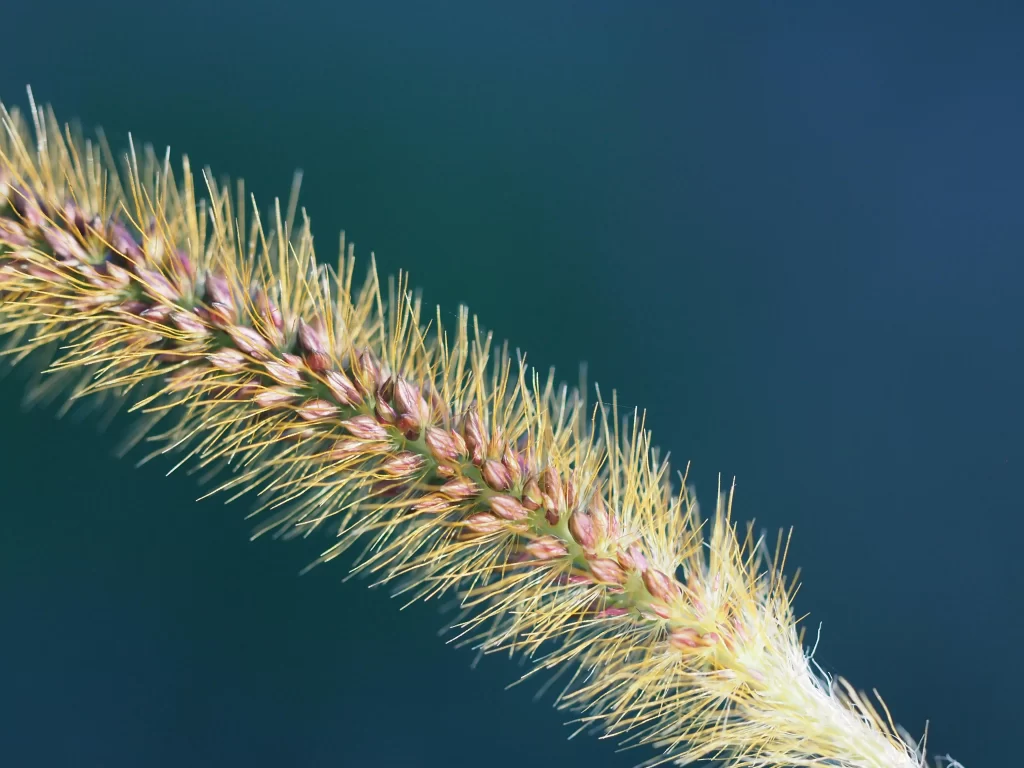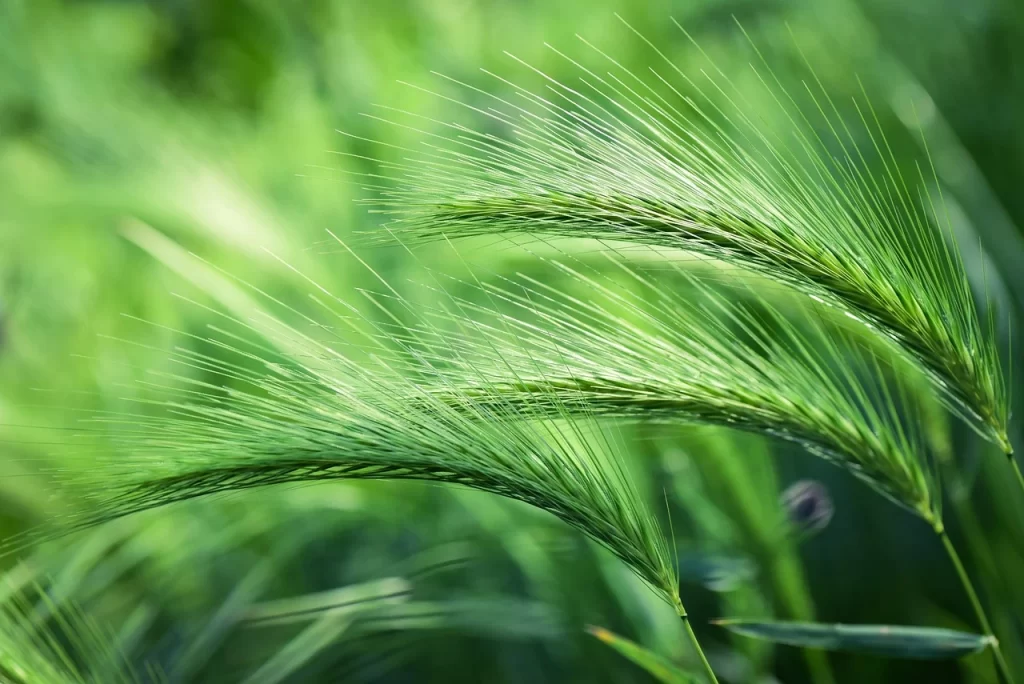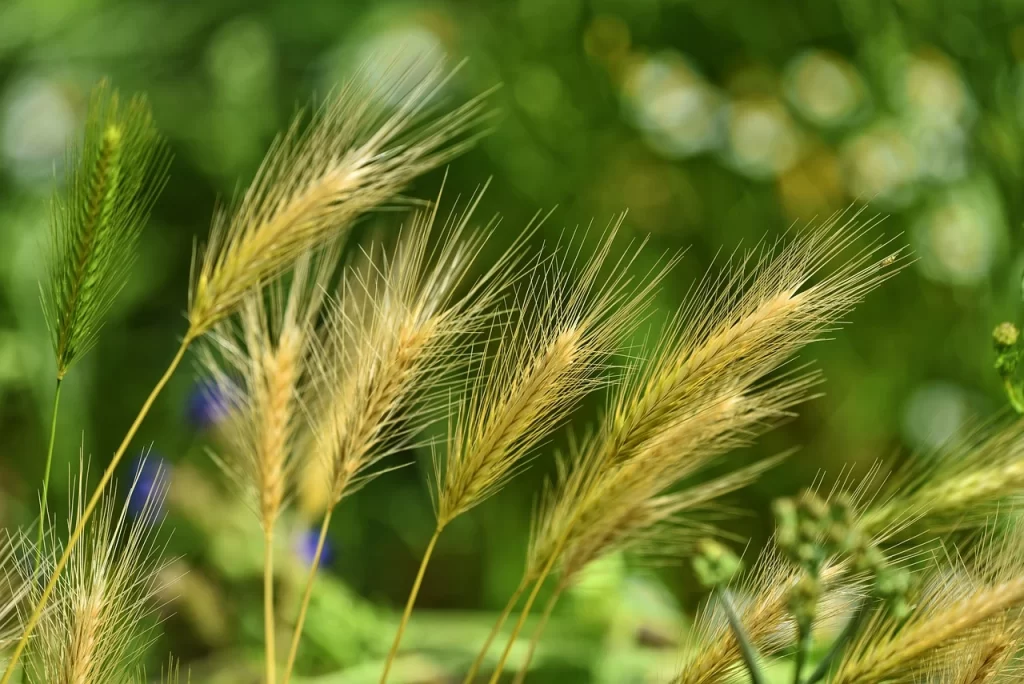In grasslands, meadows, alkaline/saline areas, and disturbed areas, Foxtail barley (Hordeum jubatum) is an endemic perennial cool-season bunchgrass. Wet meadows, seasonal water accumulations, and streams are common habitats for this one to three-foot-tall plant. Foxtail barley often coexists with other plants adapted to wet or alkali/saline conditions[1]Foxtail Grass Plant Guide. Read, such as bentgrass, inland saltgrass, Kentucky bluegrass, basin wild rye, tall wheatgrass, horsetail, and Baltic rush.
Read: Exploring the Environmental Benefits of Switchgrass Plantations
Identification of Foxtail Grass
There are three common foxtail grass species: giant foxtail (Setaria faberi), green foxtail (S. viridis), and yellow foxtail (S. pumila)[2]Identification of Different Foxtail Grass Species. Read. Giant foxtails are the largest, with arching seed heads; yellow foxtails are somewhat smaller and upright; and green foxtails are variable and can sprawl. Native wild ryes (Elymus spp.) are similar but have coarser and longer hairs on their seed heads, differing from foxtail grasses’ soft, fur-like texture.

Read: Quackgrass (Elymus repens)
Differences based on Identification between three weedy Grass
| Characteristic | Giant Foxtail (Setaria faberi) | Green Foxtail (Setaria viridis) | Yellow Foxtail (Setaria glauca) |
| Leaves Shape and Characteristics | Short, fine hairs are densely arranged on the upper leaf surface. | Hairless | Sparse, silky hairs on the upper leaf surface near the base. |
| Seedhead | Largest seedhead of the three weedy foxtails. | Seedheads can be as large as a giant foxtail but without the drooping appearance. | Smallest seedhead of three weedy foxtails. |
| Branches | A drooping, cylindrical, bristly panicle. | Cylindrical panicle. | Erect, cylindrical, and bristly. Awns develop a yellow color at maturity. |
| Stem | The base of the stem is cylindrical. | Can reach 6.5 feet in height but is usually 2.5-4 feet tall. | Agronomic fields and waste areas. The most common foxtail is found in lawns. |
| Plant Height | Fields and waste areas. The most common foxtail is found in lawns. | Can reach 3 feet in height. | Can reach 2-4 feet tall. |
| Preferred area | Prefer fields and waste areas. | Prefers acidic soils, fields, and waste areas. | Fields and waste areas. The most common foxtail is found in lawns. |
Similarities Among Yellow, Green, and Giant Foxtail
Yellow, green, and giant foxtail share several common characteristics. They are all summer annuals, typically emerging from mid-spring to early summer, although their emergence can continue throughout the growing season. For demonstration, follow the below set of instructions:
Similarities Among Yellow, Green, and Giant Foxtail:
- All three foxtail varieties (yellow, green, and giant) are summer annuals, typically emerging from mid-spring to early summer, although sporadic emergence throughout the growing season is possible.
- They have a very low tolerance to frost conditions and tend to turn brown and die after the first frost event in the fall.
- These foxtail species share a fibrous root system and a clumping growth habit.
- They display moderate drought tolerance.
- These foxtail varieties prefer fertile soil. Yellow foxtail is more common in lawns, while green and giant foxtail are frequently found in agronomic fields and waste areas.
- Green foxtails prefer more acidic soils, and their presence may indicate low soil pH.
Read: A brief introduction to major grass categories
Livestock And Foxtile Grass
Livestock can feed foxtail barley safely before seed development. Seed production occurs from late May to August, earlier at lower heights. Feeding after seed development can harm animals due to seed awns that can irritate or get lodged in the mouth, nose, skin, and eyes. Due to these awns, livestock tends to avoid feeding foxtail barley, potentially leading to its increase under heavy or continuous grazing while decreasing more edible grasses[3]Foxtail Grass effects on Livestock. Read
Read: Introduction to Major Weed Categories
Foxtail barley awns can quickly become accommodated in the hair and fur of livestock and wildlife, leading to seed transportation and contamination. Contaminated hay is unsafe for livestock and can cause symptoms like drooling and appetite loss due to inflamed mouths from awns(hairs) ingestion. Fields with foxtail barley should not be used for hay production, and hay contaminated with foxtail barley should not be fed.
Control Management
Controlling annual foxtail grasses in gardens is relatively easy with manual removal and organic herbicides[4]Read more about Control Management of Foxtail Grass. Read. Their shallow roots make removing them straightforward. For larger infestations in fields and prairies, cutting after flower/seed lead development prevents seed maturity, but repeated mowing may be necessary.

Read: Marestail weed (Horseweed) – Management and Uses
Controlling Approach
Foxtail control is a multi-year effort due to its prolific seed production. Timely techniques like mowing after flowering, using cover crops, and tillage disrupt the seed pile and stop its growth, requiring a sustained approach for effective control.
Mowing
To prevent foxtail seed development, mowing is recommended in late May to early June, with a potential second mowing later in the season for maintenance. Mowing and disposing of seed heads become necessary once seeds develop, ideally within ten days of seed head emergence.
Cover Crops
Planting competitive cover crops like clover, oats, and rye can reduce weed density and size for larger areas. Planting these cover crops in early May is most effective as late-season cover crops may need more heat for growth.
Tillage
Foxtail can be effectively controlled with tillage due to its shallow root system. It’s not necessary to overturn the soil; undercutting can work well. Tillage is more effective in the fall compared to spring.
Issues Caused By Foxtail Grass
There are several issues caused by Foxtail grass[5]FAQs about Foxtail Grass. Read. These issues are highlighted below:
Harm to Domestic Animals
With their barbed structures, foxtail seed heads can become lodged in the mouth, nose, eyes, and skin of dogs and other domestic animals, leading to severe harm. If ingested, these seed heads can embed in soft tissues, causing infections and potentially leading to fatalities.
Discomfort for People
Foxtail can adhere and stick with clothing, including fabric shoes and socks, causing discomfort and irritation, particularly while walking.

Bonus Tip–Alternatives of Foxtail Grass: To replace and compete against foxtail in full-sun areas, consider these native prairie species as alternatives. This native alternative includes Indian Grass (Sorghastrum nutans), Prairie Dropseed (Sporobolus heterolepis), Leadplant (Amorpha canescens), and so on.
Read: Indian grass (Sorghastrum nutans)
Conclusion
The foxtail grass is a perennial cool-season bunchgrass. It has three weedy foxtail species—Giant Foxtail, Green Foxtail, and Yellow Foxtail—sharing some distinct characteristics. They are all summer annuals. They possess a fibrous root system. However, they prefer fertile soil, thriving in full sun and displaying moderate drought tolerance. The article has demonstrated various aspects of foxtail grass, its control techniques, and its impact on different environments.



